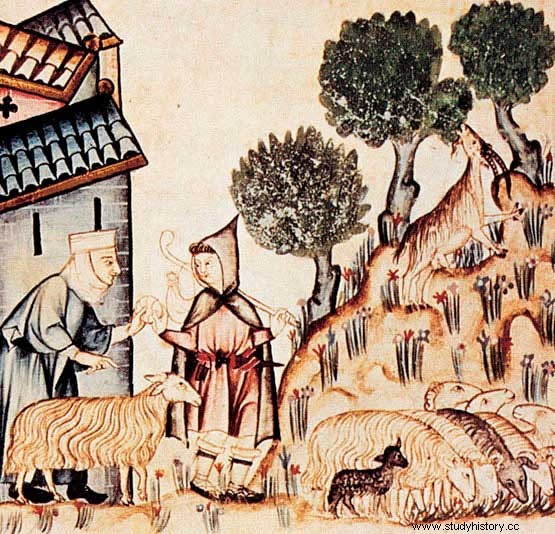The population of the kingdoms of Castilla y León continued its vegetative growth in the 13th century. Regarding economic activities, the essential line was agriculture . The main crops were cereals and vineyards, not forgetting vegetables, fruit trees and even industrial crops, such as flax. For the rest, in the 13th century the plowing process continued, the most striking aspect of that century was the incorporation into the Christian kingdoms of the fertile lands of Andalusia Betica and the orchard of Murcia, which meant, on the other hand, the development of new crops, typical of the southern lands of the Iberian Peninsula, such as olive trees, rice and fig trees.
However, the most spectacular progress occurred in the field of livestock, particularly with regard to sheep, an animal that provided wool, a fundamental raw material for the textile industry. The characteristic sheep of the lands of Castilla y León was the churra , to which, later, the so-called merino was added. . The arrival of the Christians to the southern plateau, and in particular to the rich pastures of the Guadiana valley, made the expansion of transhumance possible. The cattle moved through the ravines, which were paths located between cultivated fields. The sheep went in the winter to the warm areas of the south, the greenhouses , and in the summer to the northern mountains, the pastures . The main ravines of Castilla y León were, in the 13th century, the western or Leonese, the central or Segovian, and the eastern, also known as La Mancha or Cuenca. The owners of the herds held meetings called mestas or oteros . For its part, the cattle, when moving, had an armed guard, the esculca or rafala . In times of Alfonso X, a decisive step was taken by constituting the Honest Council of the Mesta , an institution that brought together the sheep farmers of Castilla y León. The oldest document preserved regarding the Mesta dates from the year 1273, although it seems that the institution already existed some years before. The Mesta, which had powers over all the transhumant cattle of the kingdoms of Castile and León, was dominated by the great owners of the herds, who were none other than the military orders, the cathedral churches, the great monasteries and the high nobility.
But the development of urban centers and with them of crafts and commerce also continued in the 13th century. The most outstanding activity was textiles, which were located in cities in the Duero basin, such as Zamora, Palencia, Soria or Segovia, but also in cities won over to Islam, such as Toledo, Cuenca Córdoba or Murcia. The textile production of Castilla y León was modest, at least if we compare it with the exceptional wool production of the kingdoms. Another booming activity was the foundries of the Basque Country, which were based on the iron mines of Vizcaya. It is not possible to forget, on the other hand, the importance achieved by the construction of ships.
With regard to trade in the 13th century, the fact that new fairs were created is significant, especially in cities on the southern plateau and in Andalusia; thus, in Brihuega, Alcalá de Henares, Cuenca, Cáceres, Badajoz or Seville.

